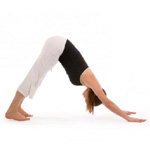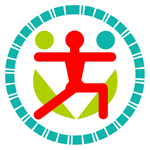With yoga you can go in many different directions. There are numerous schools that each teach their own way of yoga and if you choose to practice yoga it might take some time before you find a yoga style that suits your needs and personality. Even though these yoga styles are different, they can be seen as spokes of one and the same wheel that point to the same center. The yoga classes by Yoga Kitchen fuse influences from different yoga styles.
Yoga is essentialy a complete system for personal development to live the best life possible. We usually know yoga through the physical exercises, the postures also called asanas. But the poses are just one part of a bigger story. In the complete, eightfold path of Yoga we also find a series of concepts or principles about your relationship with the others and the world, about the relationship with yourself, breathing exercises (called pranayama), control of the senses, and concentration and meditation exercises to train the mind.
If yoga means “connection” or “unity”, this relates to the establishment of a lasting connection and link between the different layers within ourselves: our physical body, our emotions, our mind, our life energy and our spiritual Self.
If yoga means “connection” or , then yoga is about creating a body-mind link wherein the restlessness in our ego, in our emotions and in our minds is halted, Yoga helps us discover the silence within us, in which we can find treasures and possibilities hidden deep inside of ourselves of which we were totally unaware.
Those who practice yoga with a certain discipline, start to change. Yoga can transform you deeply. Yoga raises questions about the meaning and direction of your life, it can help to take up the reins of your life yourself, in order to become who you really are.
We modern Western people have often lost the true connection with ourselves, with other living creatures and with the world. Often without being conscious of it, we are constantly being manipulated, we have the feeling we are being lived, often we feel tired, suffer from stress or greater or smaller ailments and health issues. Yoga helps us to say stop to this unrest, yoga helps us to make free and conscious choices, yoga helps us to become a healthy, complete human being, healthy in both body and mind, with true compassion for all living beings, living from the wisdom of our hearts. Yoga is able to permanently improve everyone’s quality of life.
Asanas
 There must be hundreds or thousands of asanas or body postures. The aim of these postures is to strengthen and stretch the body. As a consequence, our vital energy will start to flow more freely. When you practice yoga, you will use muscles that you hardly ever use in normal daily life. That can give an uncomfortable feeling in the beginning. A yoga body posture should be experienced both as intensive and pleasant. In a yoga class, you will probably be confronted with your physical limits and personal frontiers. That is fine. The first step is to recognize and accept that you have limits today. The second step is to explore these limits and little by little start to shift them, with kindness and respect.
There must be hundreds or thousands of asanas or body postures. The aim of these postures is to strengthen and stretch the body. As a consequence, our vital energy will start to flow more freely. When you practice yoga, you will use muscles that you hardly ever use in normal daily life. That can give an uncomfortable feeling in the beginning. A yoga body posture should be experienced both as intensive and pleasant. In a yoga class, you will probably be confronted with your physical limits and personal frontiers. That is fine. The first step is to recognize and accept that you have limits today. The second step is to explore these limits and little by little start to shift them, with kindness and respect.
It is important that the asanas are being executed in the right way. That you align your body correctly and that you come in and out of the posture properly. For each body posture easier and more challenging options are available, so everyone can adapt to one’s personal level and abilities. Each asana has a specific influence on your energy level. This means that some asanas are calming, others that are activating and are able to give you an extra boost of energy.
By practicing asanas you mind will calm down and your body will be at best prepared for a moment of meditation.
Breathing
In yoga the breathing plays a key role.
 If you intend to improve the quality of your life, then it is advisable to take a close look at the way you are breathing. In order to be in perfect health, the body needs an amount of oxygen that can only be obtained by deep and complete breathing.
If you intend to improve the quality of your life, then it is advisable to take a close look at the way you are breathing. In order to be in perfect health, the body needs an amount of oxygen that can only be obtained by deep and complete breathing.
For modern Western man, breathing is often similar to drinking water: we just don’t do it enough.
The breath eliminates up to 70% of the toxic substances we absorb on a daily basis.
On average, almost 90% of the Westerners have a superficial way of breathing, a kind of survival breath. This means that most people are living constantly with a chronic lack of oxygen on a cellular level.
Holding your breath can be equally a way to avoid contact with an unwanted emotion. Let’s give an example: when we feel a sudden fear or anxiety surge within us, the breath usually stops – it is “breathtaking”. As a consequence, the emotion is not felt but suppressed and stored in the body in the form of (muscular) tension. If this is repeated often, the body will respond with chronic tensions.
He or she who breathes only in a limited way, will see his or her life experience equally limited, because your breathing scheme is a blueprint of the manner in which you stand in life.
In yoga there is a lot of deep breathing during the asana practice. The more difficult a posture is, the more one should breathe. The movements and the postures are synchronized with the breath. On top of this, a special breathing technique is often used, called ujjayi-breathing.
Due to the close link between the breathing and the asanas, it might happen that you go through an emotional moment during a yoga session. That is perfectly okay. It only shows that your vital energy starts to flow again.
In addition to this, some extra breathing exercises (pranayama) with specific goals can be done at the beginning or the end of a yoga session.
Conscious control of the breath means control over our minds, and he or she who learns to manage his or her breath wisely, will be able to better manage their lives as well.
